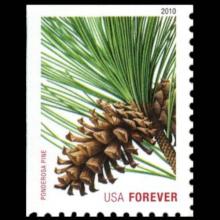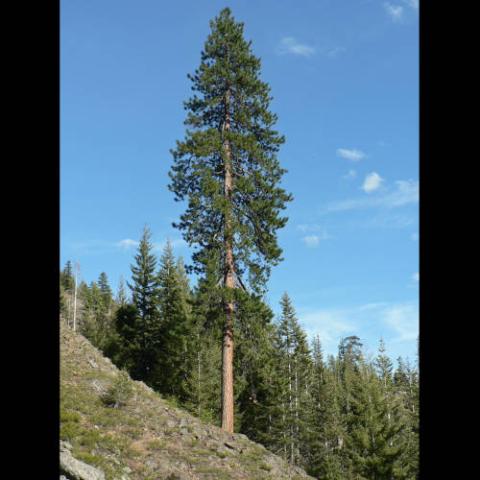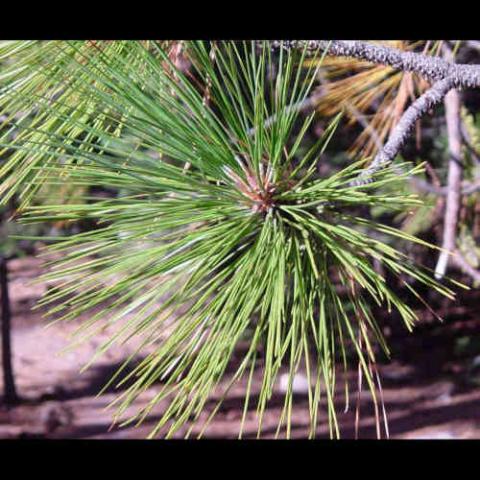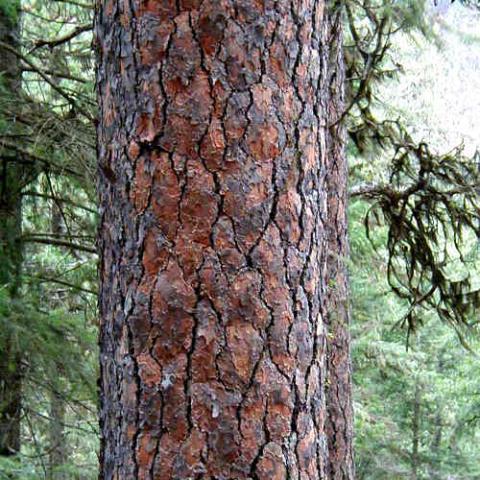NAME(S)
TAXONOMY
PLANTAE ID
THERAPEUTIC
United States
Issued:
Stamp:
Pinus ponderosa
United States
Issued:
Stamp:
Pinus ponderosa
United States
Issued:
Stamp:
Pinus ponderosa
Genus species (Plantae): Pinus ponderosa
Pinus ponderosa, commonly known as the ponderosa pine, bull pine, blackjack pine, western yellow-pine, or filipinus pine, is a very large pine tree species of variable habitat native to mountainous regions of western North America. It is the most widely distributed pine species in North America.
Pinus ponderosa grows in various erect forms from British Columbia southward and eastward through 16 western U.S. states and has been introduced in temperate regions of Europe and in New Zealand. It was first documented in modern science in 1826 in eastern Washington near present-day Spokane (of which it is the official city tree). On that occasion, David Douglas misidentified it as Pinus resinosa (red pine). In 1829, Douglas concluded that he had a new pine among his specimens and coined the name Pinus ponderosa for its heavy wood. In 1836, it was formally named and described by Charles Lawson, a Scottish nurseryman. It was adopted as the official state tree of Montana in 1949.
Description
Pinus ponderosa is a large coniferous pine (evergreen) tree. The bark helps distinguish it from other species. Mature to overmature individuals have yellow to orange-red bark in broad to very broad plates with black crevices. Younger trees have blackish-brown bark, referred to as "blackjacks" by early loggers. Ponderosa pine's five subspecies, as classified by some botanists, can be identified by their characteristically bright-green needles (contrasting with blue-green needles that distinguish Jeffrey pine). The Pacific subspecies has the longest—7+3⁄4 inches (19.8 cm)—and most flexible needles in plume-like fascicles of three. The Columbia ponderosa pine has long—4+3⁄4–8 in (12–20.5 cm)—and relatively flexible needles in fascicles of three. The Rocky Mountains subspecies has shorter—3+1⁄2–5+3⁄4 in (9.2–14.4 cm)—and stout needles growing in scopulate (bushy, tuft-like) fascicles of two or three. The southwestern subspecies has 4+1⁄2–7+3⁄4 in (11.2–19.8 cm), stout needles in fascicles of three (averaging 2+3⁄4–3+1⁄2 in or 68.5–89 mm). The central High Plains subspecies is characterized by the fewest needles (1.4 per whorl, on average); stout, upright branches at narrow angles from the trunk; and long green needles—5+3⁄4–7 in (14.8–17.9 cm)—extending farthest along the branch, resembling a fox tail. Needles are widest, stoutest, and fewest (averaging 2+1⁄4–2+3⁄4 in or 56–71 mm) for the species.
The egg-shaped cones, which are often found in great number under trees, are 3–5 in (8–13 cm) long. They are purple when first chewed off by squirrels, but become more brown and spherical as they dry. Each scale has a sharp point.
Sources differ on the scent of P. ponderosa. Some state that the bark smells of turpentine, which could reflect the dominance of terpenes (alpha- and beta-pinenes, as well as delta-3-carene). Others state that it has no distinctive scent, while still others state that the bark smells like vanilla if sampled from a furrow. Sources agree that the Jeffrey pine is more strongly scented than the ponderosa pine. When carved into, pitch-filled stumps emit a scent of fresh pitch.
Size
The National Register of Big Trees lists a ponderosa pine that is 235 ft (72 metres) tall and 27 ft (8.2 m) in circumference. In January 2011, a Pacific ponderosa pine in the Rogue River–Siskiyou National Forest in Oregon was measured with a laser to be 268 ft 4 in (81.79 m) high. The measurement was performed by Michael Taylor and Mario Vaden, a professional arborist from Oregon. The tree was climbed on October 13, 2011, by Ascending The Giants (a tree-climbing company in Portland, Oregon) and directly measured with tape-line at 268 ft 3 in (81.77 m) high. As of 2015, a Pinus lambertiana specimen was measured at 273 ft 9+1⁄2 in (83.45 m), which surpassed the ponderosa pine previously considered the world's tallest pine tree.
Distribution
Pinus ponderosa is a dominant tree in the Kuchler plant association, the ponderosa shrub forest. Like most western pines, the ponderosa is generally associated with mountainous topography. However, it is found on banks of the Niobrara River in Nebraska. Scattered stands occur in the Willamette Valley of Oregon and in the Okanagan Valley and Puget Sound areas of Washington. Stands occur throughout low level valleys in British Columbia reaching as far north as the Thompson, Fraser and Columbia watersheds. In its Northern limits, it only grows below 4,300 feet (1,300 m) elevation, but is most common below 2,600 feet (800 m). Ponderosa covers 1 million acres (4,000 km2), or 80%, of the Black Hills of South Dakota. It is found on foothills and mid-height peaks of the northern, central, and southern Rocky Mountains, in the Cascade Range, in the Sierra Nevada, and in the maritime-influenced Coast Range. In Arizona, it predominates on the Mogollon Rim and is scattered on the Mogollon Plateau and on mid-height peaks (6,000 to 9,300 feet; 1,800 to 2,800 m) in Arizona and New Mexico. Arizona pine (P. arizonica), found primarily in the mountains of extreme southwestern New Mexico, southeastern Arizona, and northern Mexico and sometimes classified as a variety of ponderosa pine, is presently recognized as a separate species. Ponderosa pine are also found in the Chisos, Davis, and Guadalupe Mountains of Texas, at elevations between 4,000 and 8,000 feet (1,200 and 2,400 m).
Ecology
The fire cycle for ponderosa pine is 5 to 10 years, in which a natural ignition sparks a low-intensity fire. Low, once-a-decade fires are known to have helped specimens live for half a millennium or more. The tree has thick bark, and its buds are protected by needles, allowing even some younger individuals to survive weaker fires. In addition to being adapted to dry, fire-affected areas, the species often appears on the edges of deserts as it is comparatively drought resistant, partly due to the ability to close its leaf pores. It can also draw some of its water from sandy soils. Despite being relatively widespread in the American West, it is intolerant of shade.
Pinus ponderosa needles are the only known food of the caterpillars of the gelechiid moth Chionodes retiniella. Blue stain fungus, Grosmannia clavigera, is introduced in sapwood of P. ponderosa from the galleries of all species in the genus Dendroctonus (mountain pine beetle), which has caused much damage. Western pine and other beetles can be found consuming the bark. The seeds are eaten by squirrels, chipmunks, quail, grouse, and Clark's nutcracker, while mule deer browse the seedlings. American black bears can climb up to 12 feet up a ponderosa.
Various animals nest in the ponderosa pines, such as the piliated woodpecker.
Uses
Native Americans consumed the seeds and sweet inner bark. They chewed the dried pitch, which was also used as a salve. They used the limbs and branches as firewood and building material, and the trunks were carved into canoes. The needles and roots were made into baskets. The needles were also boiled into a solution to treat coughs and fevers.
In the 19th and 20th centuries, old-growth trees were widely used by settlers as lumber, including for railroads. Younger trees are of poor quality for lumber due to the tendency to warp.
Reference: Wikipedia, pfaf.org
Photo: Wikimedia Commons (Walter Siegmund)




